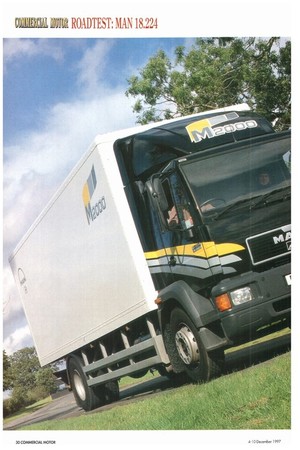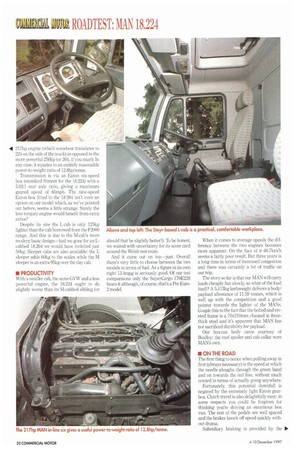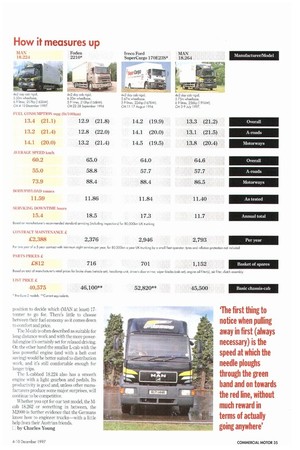ROADTEST: MAN 18.224
Page 32

Page 33

Page 34

Page 36

Page 37

If you've noticed an error in this article please click here to report it so we can fix it.
RETURN MATCH
It's a pity that Steyr's foray into the UK market didn't last longer; the 17-tonner we tested back in 1989 left a good impression. But its distant cousin is here, calling itself the MAN 18.224. So have the Germans improved on the Austrian original?
Ever had a feeling of deja vu? CM readers with long memories may be forgiven for thinking they've stumbled into a time warp, because at first glance the MAN 18.224 17-tonner looks remarkably like the Steyr 17S21 we tested way back in February 1989. Are they in any way related?
Well, if we remind you that MAN now owns the Austrian truck manufacturer things might fall into place. The cab is in fact a much-revised version of the one that appeared in the Steyr roadtest, in which we concluded that it would be a serious contender for UK sales.: In the event, it wasn't to be. MAN put a stop to Steyr's trucks being sold in the UK— but was shrewd enough to adapt the cabs for its own purposes.
This one is the smaller of the two cabins offered in the M2000 range. We tested its big brother, the M-cabbed 18.264, back in July: it was the first and, so far, only Euro-2 17-ton
ner to go round our revised Welsh route. With such limited competition the L cab stood a good chance of snatching the fuel record.
II PRODUCT PROFILE
PHOTOGRAPHY by RICHARD CONNELLY
Apart from its guest appearance with Steyr, we've also met the L-cab with MAN's 6-10 tonne L2000 range. For the M2000s, however, it's been raised 60mm to accommodate the larger engines and has a new lower section with revised mudwings and step.
The M-cab comes from MAN's F2000 heavy truck range, but that aside there's little difference between the two variants. They come with the same choice of engine/gearbox combination and the running gear is virtually identical. They also share chassis frames, axles, braking systems (including front discs) and electrics. It's only when you get to the wheelbase that you notice any real difference (see table, page 33).
Our test model was fitted with MAN's Ito
41 217hp engine (which somehow translates to 224 on the side of the truck) as opposed to the more powerful 256hp (or 264, if you must). In any case, it equates to an entirely reasonable power-to-weight ratio of 12.8hp/tonne.
Transmission is via an Eaton six-speed box (standard fitment for the 18.224) with a 5.92:1 rear axle ratio, giving a maximum geared speed of 65mph. The nine-speed Eaton box fitted to the 18.264 isn't even an option on our model which, as we've pointed out before, seems a little strange. Surely the less torquey engine would benefit from extra ratios?
Despite its size the I–cab is only 125kg lighter than the cab borrowed from the F2000 range. And this is due to the M-cab's more modern basic design—had we gone for an Lcabbed 18.264 we would have forfeited just 50kg. Sleeper cabs are also available: the L sleeper adds 60kg to the scales while the M sleeper is an extra 95kg over the day cab.
• PRODUCTIVITY With a smaller cab, the same GVW and a less powerful engine, the 18.224 ought to do slightly worse than its M-cabbed sibling (or should that be slightly better?). To be honest. we waited with uncertainty for its score card around the Welsh test mute.
And it came out on top—just. Overall there's very little to choose between the two models in terms of fuel. As a figure in its own right 13.4mpg is seriously good. Of our test comparisons only the SuperCargo 170E23S beats it although, of course, that's a Pre-Euro2 model. When it comes to average speeds the difference between the two engines becomes more apparent. On the face of it 60.7km/h seems a fairly poor result. But three years is a long time in terms of increased congestion and there was certainly a lot of traffic on our trip.
The story so far is that our MAN will carry loads cheaply but slowly, so what of the load itself? A 5,413kg kerbweight delivers a body/ payload allowance of 11.59 tonnes, which is well up with the competition and a good pointer towards the lighter of the MANs. Couple this to the fact that the bolted-and-riveted frame is a 70x210mm channel in 8mm• thick steel and it's apparent that MAN has not sacrificed durability for payload.
Our boxvan body came courtesy of Boalloy; the roof spoiler and cab collar were MAN's own.
• ON THE ROAD The first thing to notice when pulling away in first (always necessary) is the speed at which the needle ploughs through the green band and on towards the red line, without much reward in terms of actually going anywhere.
Fortunately, this potential downfall is negated by the extremely light Eaton gearbox. Clutch travel is also delightfully easy: in some respects you could be forgiven for thinking you're driving an enormous box van. The rest of the pedals are well spaced and the brakes knock off speed quickly without drama.
Subsidiary braking is provided by the standard exhaust brake which works well if you keep the revs up. The positioning of the control could have been better, however, but you can get used to it.
The parabolic spring suspension gives a controlled ride with no unpleasant jarring or feelings of seasickness. The front and rear stabilisers were well up to the job as body roll was virtually non-existent—MAN has certainly got this side of things right.
Grunt from the six-pot diesel is less impressive; the gearbox has to be used to full effect as the extra weight takes its toll, compared with the 12224 we drove at the beginning of the year. Having said that, the standing-start acceleration and hill climb times are hardly disastrous.
A useful feature was the speed limiter situated on the right-hand stalk. Useful, that is, when we could get it to work. On a number of occasions we pressed it at the required speed and it failed to come on. This prompted constant checks to see whether it was functioning...no mean feat considering the "on" light was blocked by the steering wheel.
• CAB COMFORT
The old Steyr cab was good and MAN has developed it further, into a comfortable and practical driving environment. A decent driving position can be found easily thanks to the adjustable steering column and driver's seat which remains soft throughout a full day's driving.
Extra soundproofing has been developed, mainly thanks to Euro-2, and it seems to have worked: the radio was at the same volume when we were stationary as when cruising at 56mph—good news indeed.
Entry into the cab is easier than in the smaller L2000, thanks mainly to revised step wells, but the door still doesn't open to 900.
Ergonomically MAN favours the no-nonsense approach with a commendably clear dash and all controls (excluding the speed limiter) being easy to use.
Stowage space is another strong point. There's the usual glovebox and door pockets but also three fair-sized recesses above the ventilation controls (heating and ventilation are great by the way) and some useful overhead-dash storage.
• SUMMARY
We've now tested both an M-cabbed 18.264 and an L-cabbed 18.224, so we're in a good position to decide which (MAN at least) 17tonner to go for. There's little to choose between their fuel economy so it comes down to comfort and price.
The M-cab is often described as suitable for long distance work and with the more powerful engine it's certainly set for relaxed driving. On the other hand the smaller L-cab with the less powerful engine (and with a heft cost saving) would be better suited to distribution work, and it's still comfortable enough for longer trips.
The L-cabbed 18.224 also has a smooth engine with a light gearbox and pedals. Its productivity is good and, unless other manufacturers produce some major surprises, will continue to be competitive.
Whether you opt for our test model, the Mcab 18.262 or something in between, the M2000 is further evidence that the Germans know how to engineer trucks-with a little help from their Austrian friends.
L by Charles Young
Price as tested: £45,775 (ex-VAT). Includes £40,575 for the chassis-cab and £5,200 for the Boalloy box body.
Engine:6.9 litres, 217hp (162kW). GVW: 17,000kg.
Body/payload allowance: 11.4 tonnes. Fuel consumption (laden): 13.4mpg (21.11it/100km).
DRIVERS' VERDICTS
Having completed the test route we followed our usual practice by taking to the road and asking regular drivers to take a spin and give their views. In the case of the MAN 18.224 we buttonholed drivers at BP's Swindon truckstop.
We invited Peter Riley to join us from the cab of his Volvo FH12 380, which he drives for Steve Benton Transport out of Birmingham. He told us that he occasionally pilots 17-tanners so driving the MAN 4x2 did not come as too much of a culture shock. "The gear change is nice and light," he remarked as we got underway. "I think I could get on with this all right. The engine feels responsive and it seems to want to go," he added, while containing the tacho needle to the solid green sector. "It has the typical turbo wail but it does pull well. I'm spoilt for ride in my Volvo; this is much firmer without a suspension seat. The noise level's not bad but there's a bit of wind noise," he noted as we ran along a stretch of dual carriageway. "The curve of the nearside screen pillar and the mirrors create a blind spot and the quarter light obstructs the mirror on this side. It's a bit like the Mercedes 17-tormer," he said. "The steering wheel cuts across my line of view for the lower instruments. The front screen is nice and deep so vision is good in front. I like the idea of the triple wipers—Volvo used to fit three as well. The brakes are not too fierce but they do respond," he said as we stopped at a road junction. Then, taking off once more: "First to second gear is much looser if the engine revs are not token so high. The indicator warning could do with being a bit louder. I think I would be happy to do multi-delivery work in it. It's got a good strong strap on the door," he concluded as he stepped down. Bernie O'Connor drives a Volvo FL6 for Richman's haulage and removals in Swindon. "It pulls like it's empty," was his first reaction. "I'd like to see how it does on a real hill. The ride is quite reasonable but they all ride better with a load anyway. At 50mph the engine is not really working very hard—it's only turning over at 1,600rpm. It's nice to see all these mirrors included as standard; you'd be blind close to the nearside without the lowest one. Vision is good all round. I can see the instruments OK but I'd like to see how clear they are at night before finally passing 'judgment. The gear lever is a long stretch forward but the change is very smooth," he added. "The pedals are reasonably light but under light load the accelerator is at an angle that could make your ankle ache after a while. It's a lot quieter than my Volvo but that is a bit older. I'm not a smoker, but I'd want the ashtray to be high up on the dash, if I were. The trim is very light—only time will tell how clean it will stay."
Peter Riley: "I think I'd be happy to do multi-delivery work in it."
Bernie O'Connor: "It's nice to see all these mirrors included as standard."
















































































































